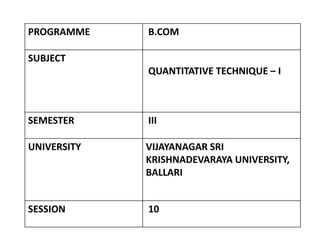
Frequency Distribution Table 3
- 1. PROGRAMME B.COM SUBJECT QUANTITATIVE TECHNIQUE – I SEMESTER III UNIVERSITY VIJAYANAGAR SRI KRISHNADEVARAYA UNIVERSITY, BALLARI SESSION 10
- 2. RECAP • Preparation of Frequency Distribution Table Discrete Series Problems -- 02
- 3. LEARNING OBJECTIVES • The aim of the chapter is to make students to present data in textual and Tabular format including the technique of creating frequency distribution and working out bi-variate distribution table
- 4. LEARNING OUTCOMES • After the Chapter, The Students Shall be able to Describe and Understand the Rules & Types of Classification, Frequency Distribution, Class Interval & its Types, Basic Principles Tabulation and The Sorting of Data.
- 5. SESSION - 10 • Preparation of Frequency Distribution Table - Continuous Series Problems ----------- 01
- 6. CONTINUOUS FREQUENCY DISTRIBUTION • In statistics Frequency distribution continuous is an arrangement of the values that one or more variables take in a sample. • Each entry in the table contains the frequency or count of the occurrences of values within a particular group or interval, and in this way, the table summarizes the distribution of values in the sample.
- 7. CONTD • Data collected from tests and experiments may have little meaning to the investigator until they have been arranged or classified in some systematic way. • The steps in grouping may be summarized as follows: 1. Decide on the number of classes. 2. Determine the range, i.e., the difference between the highest and lowest observations in the data. 3. Divide range by the number of classes to estimate approximate size of the interval (h or C).
- 8. CONTD 4. Find the lower class limit of the lowest class and add to it the class- interval to get the upper class limit. 5. Obtain class-limits for the remaining classes by adding the class-interval to the limits of the previous class. 6. Count numbers of frequencies in each class and check against the total number of observations
- 9. EXAMPLE • Consider the following marks (out of 50) obtained in Mathematics by 60 students of Class VIII: 21, 10, 30, 22, 33, 5 , 37, 12, 25, 42, 15, 39, 26, 32, 18, 27, 28, 19, 29, 35, 31, 24,36, 18, 20, 38, 22, 44, 16, 24, 10, 27, 39, 28, 49, 29, 32, 23, 31, 21, 34, 22, 23, 36, 24, 36, 33, 47, 48, 50 , 39, 20, 7, 16, 36, 45, 47, 30, 22, 17. Construct grouped frequency distribution table taking 10 Class interval.
- 10. CONTD CLASS INTERVAL TALLY MARKS FREQUENCY 0-10 II 02 10-20 IIII IIII 10 20-30 IIII IIII IIII IIII I 21 30-40 IIII IIII IIII IIII 19 40-50 IIII II 07 50-60 I 01 TOTAL 60
- 11. SUMMARY As we already discussed and learnt today on Classifications and Tabulation as below • Preparation of Frequency Distribution Table - Continuous Series Problems ----------- 01
- 12. MCQs 1 . The grouped data are called: (a) Primary data (b) Secondary data (c) Raw data (d) Difficult to tell 2 . A series of data with exclusive classes along with the corresponding frequencies is called: (a) Discrete frequency distribution (b) Continuous frequency distribution (c) Percentage frequency distribution (d) Cumulative frequency distribution
- 13. MCQs 3 . In an exclusive classification, the limits excluded are (a) Upper limits (b) Lower limits (c) Both lower and upper limits (d) Either lower or upper limits 4 . Weights; 15-20, 20-25, 25-30, 30-35, 35-40 No.of items 10, 15, 30 , 10, 5, The above series is categorized as: (a) Continuous series (b) Discrete series (c) Time series (d) Geometric series
- 14. MCQs 5 . The number of classes in a frequency distribution is obtained by dividing the range of variable by the: (a) Total frequency (b) Class interval (c) Mid-point (d) Relative frequency
- 15. CONTD ANSWERS 1. B 2. B 3. D 4. A 5. B
- 16. REFERENCES • S.P. Gupta, Sultan Chand and Sons Publications, 2017 • S. C. Gupta, Himalaya Publishing House, Fundamentals of Statistics, 2018 • R.S.N Pillai and Bagavathi, S.Chand publications, 2010
- 17. THANK YOU